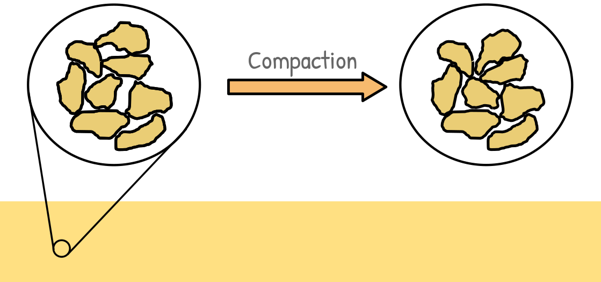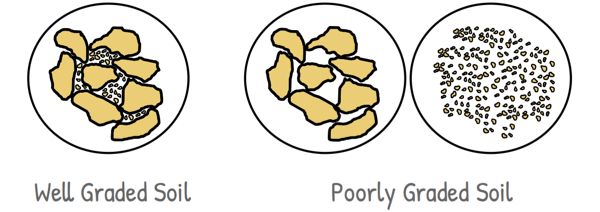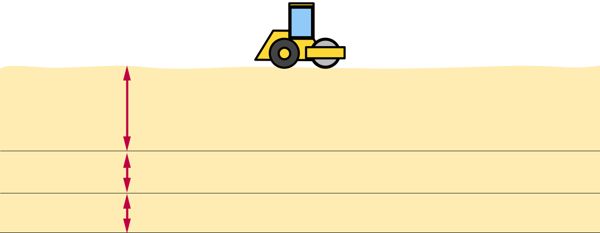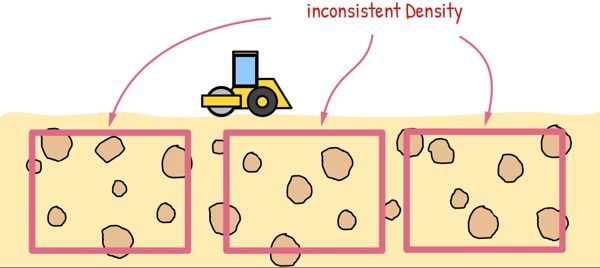We make the soil base stable and strong Before constructing any structure on it. And the process of doing so is called Compaction.
Compaction is done by increasing soil’s density by decreasing the volume of air voids in it.

It is done using heavy machinery and equipments. Compaction is measured using Dry Unit weight or Dry Density of Soil. Higher the Dry density, higher is the compaction.
Dry Density of Soil is nothing but density of soil when it is in completely dry state which means no water is present in its pores. So the Dry Density of soil is mass of soil solids only divided by its volume.
Our aim is to compact the soil as much as possible using easier and cost-effective methods. There are several factors that influence the soil compaction. By identifying and managing these factors, we can maximize compaction levels with ease, ensuring a more effective and cost-efficient approach to our goal.
Factors affecting compaction:
water content
amount of compaction
type of soil
Method of Compaction
Admixture
thickness of layer
saturation line
stone content
gradation
temperature
initial soil density
Let’s discuss some of these factors affecting the soil compaction.
Water Content
Soil scientist and civil engineer R. R. Proctor devised an experiment named after him as “Standard Proctor Test”. In the test soil is compacted by adding different amount of water contents to it and respective Dry Densities obtained are recorded. The obtained data is plotted in a curve that is known as Compaction Curve.

The relationship observed between the dry density of soil and water content present was explained by Lubrication Theory.
At low water content, the soil is stiff and the soil grains offer more resistance to compaction. As the water content is increased, water acts as a lubricating agent and helps particles move more easily to achieve denser configuration. This way dry density of soil begins increasing.
The Dry Unit Weight continues to increase till a maximum value is reached. Then if we keep on adding the water to the soil, the dry unit weight begins to decrease because now water begins to occupy the space that otherwise might have been occupied by the soil particles.

So in the compaction curve we can notice that soil achieves its Maximum Dry Density or we can say soil is most compacted at a certain moisture content known as the optimum moisture content. This means, when we’re working in the field, it’s best to compact the soil at this specific moisture content (OMC).
Amount of compaction / Compactive Effort
Compactive effort refers to the energy applied to compact the soil, often measured in terms of weight or force per unit area. This energy can be generated by the weight of construction equipment, like rollers, or through other compaction methods.
The greater the compactive effort, the more force there is to push out air and to reduce air voids. And that makes the soil denser, solid and stable. So, the level of compactive effort directly influences how well the soil gets compacted.
The compaction curve received is unique for a given soil type, method of compaction and compactive effort. If we increase or decrease the compactive efforts the Dry Unit Weight and hence the compaction of soil will increase or decrease respectively.
Higher the compactive effort, higher is the Maximum Dry Unit Weight and lower is the Optimum Moisture Content. This means we will need less amount of water to compact the soil, to help it achieve its maximum dry density.

This phenomenon is also evident when we compare the compaction curve obtained via Standard Proctor Test to that of Modified Proctor Test. We know that compactive efforts in Modified Proctor Test are higher than in Standard Proctor Test. We can see the compaction curve shifts to the top and to the left when the compactive effort is increased.

We should also note that, the Maximum Dry Unit Weight doesn’t keep on increasing with an increase in the compactive effort. The margin of increase for a certain increase in the compactive effort gets smaller and smaller, especially on the dry side of the optimum moisture content (OMC). While, on the wet side, there is hardly any increase at all.
Hence To achieve optimum compaction, one needs to find the right balance.
Type of Soil
Soils are generally classified into different types based on their particle size and composition. Upon compaction maximum dry unit weight achieved and respective optimum water content is different for different soils.

Coarse-grained soils, like sand, usually achieve higher dry unit weight when compacted compared to fine-grained soils such as clay. It happens because of the fact that fine-grained soils, with their smaller flaky and plate like particles, tend to have more void spaces between the particles even when compacted. These void spaces reduce the overall density of the soil, resulting in a lower dry unit weight.

But when we introduce even a small amount of fine particles to coarse-grained soil, it significantly increases the dry unit weight with the same compactive effort. It happens simply because fine soils fill the voids in the coarse-grained soils.
However, if we add more fines than necessary to fill the gaps in coarse-grained soils, the maximum dry density decreases.
Cohesive soils which are fine-grained soils need more water for compaction, resulting in a higher Optimum Moisture Content (OMC) also they exhibit very low dry density.
Finding the right balance in soil composition is key to achieving optimal compaction results.
Gradation of Soil
We just discussed that adding some amount of fines to the coarse soils improves its dry density as fines fill the voids of the coarse-grained soils. By doing so we improved the gradation of the soil.
And it is evident that a well-graded soil achieves a much higher dry unit weight than a poorly-graded soil. A well graded soil is a good mix of particles of different sizes.

A poorly graded or uniform sand leads to lowest dry unit weight.
Bulking of Sand
While compacting the soil we should keep in mind that pure Sand soils exhibits completely different behaviour on compaction because of the property of sand called Bulking of Sand. Bulking of sand is increase in sand’s volume while they come in contact with water. Bulking of sand has been discussed in detail in our earlier post.
Method of Compaction
In the laboratory tests, we generally compact soil samples using impact methods. However, in the field, compaction methods we use may be of rolling, kneading, vibrational or impact types.

Each method of compaction applies different forces and energy to the soil which affects its density in unique ways. As a result, each compaction method produces its own compaction curves. Consequently, there may be variations in Optimum Moisture Content (OMC) and Maximum Dry Density Yd(max) values among the various compaction methods.
For the same amount of compactive effort, the Maximum Dry Unit Weight will depend upon the chosen method of compaction.
In addition to all the factors that we discussed there are many other factors that influences the compaction of soil
For example when we compact soil for a fill, we do it in layers. If these layers are thicker, they need more passes or a greater compactive effort to achieve the desired level of compaction.

Soil’s initial density also affects the compactive efforts required. Loose soils generally require more effort than a soil that is already dense.
Also compacting soils with high stone content may require more energy, as stones resist compression more than soil particles. This increased resistance can necessitate additional compaction effort. In addition to that it can be challenging to achieve consistent compaction density throughout the soil profile, if these stones are irregularly distributed.

Mineral composition of soil particles also plays a significant role in compaction. Certain minerals in the soil have a natural affinity for water molecules. They can attract water and hold it close to their surfaces and contribute to the soil’s moisture-retaining capacity, affecting factors such as Optimum Moisture Content (OMC) and compaction density.

All these various factors play a crucial role in compacting the soil. Understanding and managing these factors is essential for achieving effective compaction, ensuring a stable foundation for construction projects.






